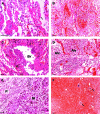Severe novel influenza A (H1N1) infection in cancer patients
- PMID: 20511340
- PMCID: PMC2990816
- DOI: 10.1093/annonc/mdq254
Severe novel influenza A (H1N1) infection in cancer patients
Abstract
Background: The natural history and consequences of severe H1N1 influenza infection among cancer patients are not yet fully characterized. We describe eight cases of H1N1 infection in cancer patients admitted to the intensive care unit of a referral cancer center.
Patients and methods: Clinical data from all patients admitted with acute respiratory failure due to novel viral H1N1 infection were reviewed. Lung tissue was submitted for viral and bacteriological analyses by real-time RT-PCR, and autopsy was conducted on all patients who died.
Results: Eight patients were admitted, with ages ranging from 55 to 65 years old. There were five patients with solid organ tumors (62.5%) and three with hematological malignancies (37.5%). Five patients required mechanical ventilation and all died. Four patients had bacterial bronchopneumonia. All deaths occurred due to multiple organ failure. A milder form of lung disease was present in the three cases who survived. Lung tissue analysis was performed in all patients and showed diffuse alveolar damage in most patients. Other lung findings were necrotizing bronchiolitis or extensive hemorrhage.
Conclusions: H1N1 viral infection in patients with cancer can cause severe illness, resulting in acute respiratory distress syndrome and death. More data are needed to identify predictors of unfavorable evolution in these patients.
Figures



Similar articles
-
Lung Histopathology in Coronavirus Disease 2019 as Compared With Severe Acute Respiratory Sydrome and H1N1 Influenza: A Systematic Review.Chest. 2021 Jan;159(1):73-84. doi: 10.1016/j.chest.2020.09.259. Epub 2020 Oct 7. Chest. 2021. PMID: 33038391 Free PMC article.
-
Critically Ill patients with 2009 influenza A(H1N1) in Mexico.JAMA. 2009 Nov 4;302(17):1880-7. doi: 10.1001/jama.2009.1536. Epub 2009 Oct 12. JAMA. 2009. PMID: 19822626
-
Critically ill patients with 2009 influenza A(H1N1) infection in Canada.JAMA. 2009 Nov 4;302(17):1872-9. doi: 10.1001/jama.2009.1496. Epub 2009 Oct 12. JAMA. 2009. PMID: 19822627
-
Intensive-care patients with severe novel influenza A (H1N1) virus infection - Michigan, June 2009.MMWR Morb Mortal Wkly Rep. 2009 Jul 17;58(27):749-52. MMWR Morb Mortal Wkly Rep. 2009. PMID: 19609249
-
Hemophagocytic lymphohistiocytosis associated with influenza A (H1N1) infection in a patient with chronic lymphocytic leukemia: an autopsy case report and review of the literature.Ann Diagn Pathol. 2012 Dec;16(6):477-84. doi: 10.1016/j.anndiagpath.2011.03.009. Epub 2011 Jul 2. Ann Diagn Pathol. 2012. PMID: 21724431 Review.
Cited by
-
How Does Influenza A (H1N1) Infection Proceed in Allogeneic Stem Cell Transplantation Recipients?Turk J Haematol. 2012 Mar;29(1):63-6. doi: 10.5152/tjh.2011.74. Epub 2012 Mar 5. Turk J Haematol. 2012. PMID: 24744625 Free PMC article.
-
Pandemic H1N1 influenza A viral infection complicated by atypical hemolytic uremic syndrome and diffuse alveolar hemorrhage.Clin Exp Nephrol. 2011 Dec;15(6):948-52. doi: 10.1007/s10157-011-0516-z. Epub 2011 Aug 10. Clin Exp Nephrol. 2011. PMID: 21826588
-
Lung Histopathology in Coronavirus Disease 2019 as Compared With Severe Acute Respiratory Sydrome and H1N1 Influenza: A Systematic Review.Chest. 2021 Jan;159(1):73-84. doi: 10.1016/j.chest.2020.09.259. Epub 2020 Oct 7. Chest. 2021. PMID: 33038391 Free PMC article.
-
Noninvasive mechanical ventilation in high-risk pulmonary infections: a clinical review.Eur Respir Rev. 2014 Dec;23(134):427-38. doi: 10.1183/09059180.00009413. Eur Respir Rev. 2014. PMID: 25445941 Free PMC article. Review.
-
A prospective study of the factors shaping antibody responses to the AS03-adjuvanted influenza A/H1N1 vaccine in cancer outpatients.Oncologist. 2012;17(3):436-45. doi: 10.1634/theoncologist.2011-0342. Epub 2012 Feb 21. Oncologist. 2012. PMID: 22357731 Free PMC article. Clinical Trial.
References
-
- Thirumala R, Ramaswamy M, Chawla S. Diagnosis and management of infectious complications in critically ill patients with cancer. Crit Care Clin. 2010;26:59–91. - PubMed
-
- Danai PA, Moss M, Mannino DM, Martin GS. The epidemiology of sepsis in patients with malignancy. Chest. 2006;129:1432–1440. - PubMed
-
- Update: swine influenza A (H1N1) infections—California and Texas, April 2009. MMWR Morb Mortal Wkly Rep. 2009;58:435–437. - PubMed
-
- Dawood FS, Jain S, Finelli L, et al. Emergence of a novel swine-origin influenza A (H1N1) virus in humans. N Engl J Med. 2009;360:2605–2615. - PubMed
Publication types
MeSH terms
LinkOut - more resources
Full Text Sources
Medical

